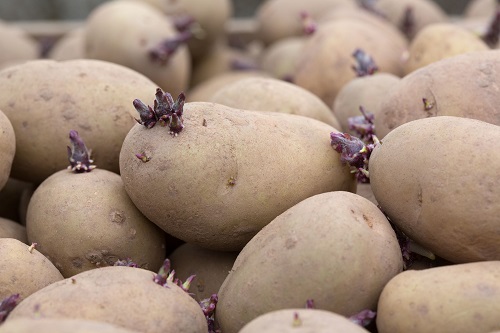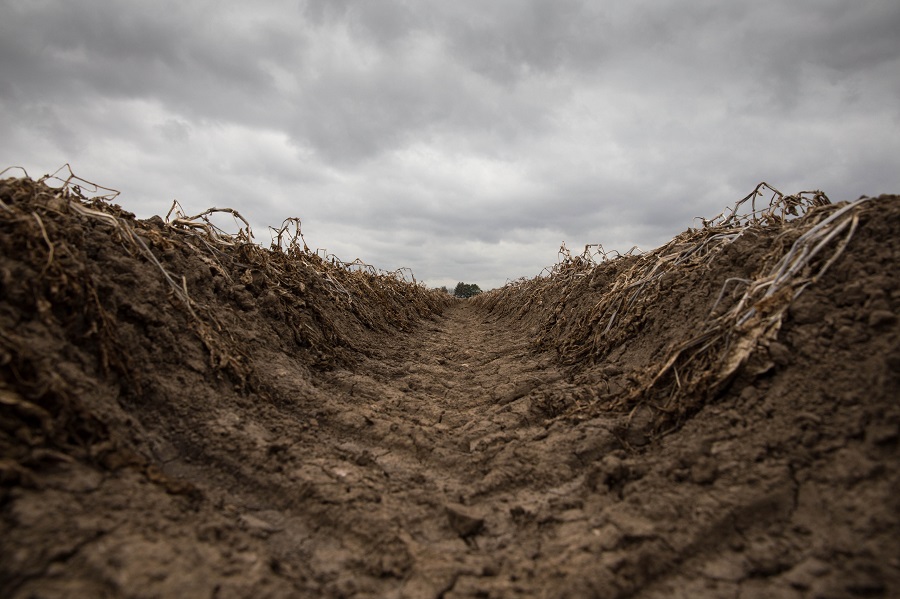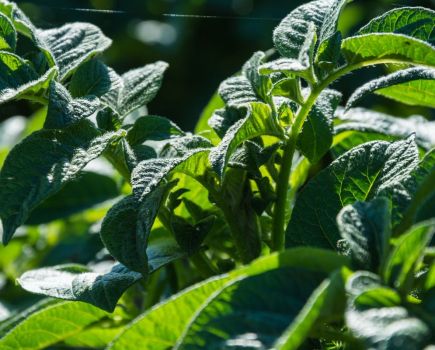Potato growers are understandably anxious about achieving quality haulm knock down with an ever- decreasing product portfolio. Diquat’s demise has certainly made its impact felt. But at FMC we have seen excellent and comparable results where a flail and spray approach in combination with Spotlight Plus has been adopted.
Under the Spotlight
Successful desiccation starts with managing the canopy in the new era without diquat. CPM asks how to get the best out of PPO inhibitors at burn-down.
Managing the canopy is going to hold the key to success.
By Lucy de la Pasture
For the first season in memory, potato crops have been planted in the knowledge that desiccation strategies later in the season are without a first in-line chemical treatment to remove foliage. Diquat had taken on that mantle when glufosinate ammonium and sulphuric acid were withdrawn. All’s that now left are the protoporphyrinogen oxidase inhibitors (PPOs), which were developed as a second line of treatment to desiccate stems.
CPM talks to FMC’s agronomy manager Jeff Fieldsend and taps into his long experience with the company’s PPO, Spotlight Plus (carfentrazone-ethyl), to find out how agronomy practices will play a part in getting the best out of the available chemistry.

Practices such as chitting seed physiologically age the seed, making the crop earlier maturing and potentially easier to burn down.
How will desiccation practice change?
Many desiccation regimes have previously been based on foliar applications of diquat, but its loss means some growers will move to flail and spray instead. It’s estimated 60-70% of the potato crop will be under a flail and spray strategy this autumn as it’s the quickest and most effective regime, but it won’t suit all growers for a variety of reasons.
Potential drawbacks from flail operations are very much driven by soil type and weather conditions and can include compaction, extra wheelings though the crop and operational difficulty if conditions turn wet. Some soil types can erode more easily than others and this can result in a reduction of the ridge and greater exposure of the tubers to light. Under these circumstances flailing can cause a bigger issue with greening.
How will this affect crop agronomy?
Where growers are sticking to a chemical desiccation strategy, managing the canopy is going to hold the key to success, particularly where indeterminate varieties are grown – such as, Markies, Rooster and Royal. Potentially it will be necessary to monitor nitrogen inputs more carefully, with a reduction of 30-50kgN/ha likely to help manage the canopy.
Some growers manage alternaria infections by using nitrogen to help maintain green leaf area, particularly Alternaria alternata which is a secondary pathogen and often comes into susceptible varieties (such as Markies) on the back of crop stress. This is a practice where growers may consider the implications on crop growth later in the season, particularly if the nitrogen applied could delay the onset on senescence.
Chemical desiccation using PPOs will be a slower process than with diquat, so it’s going to be important to maintain tuber blight protection until the crop is completely dead. That will mean planning ahead to keep enough blight chemistry with tuber blight activity for the end of the season.
Does physiological age make a difference?
Physiological age is akin to the internal clock of the potato seed. It increases with time (chronological age) and is determined from the time of tuber initiation onwards. Temperature is the largest single factor that affects the physiological age of a seed tuber and the higher the temperature, then the greater the increase in physiological age.
The physiological age of seed when it’s planted is often an unknown but has a huge effect on crop development. Physiologically young seed will emerge later, have fewer stems/tuber and more foliage growth. It will also have a higher tuber number per stem and be later maturing. All of these factors have ramifications for desiccation.
Seed that has been grown under stress conditions, such as high temperatures or water stress, will have an ‘older’ physiological age at planting than seed grown under low stress conditions. In 2019 the seed was grown during the hot, dry summer of 2018 so was physiologically aged at planting and this was one of the main reasons that desiccation was straightforward last year.
Practices such as chitting seed to break dormancy increase both the chronological and physiological age of the seed, encouraging quick emergence, fewer stems/plant and an earlier onset of senescence. Although not as popular as in previous decades, in part due to modern planters damaging the chits, ageing seed in this way offers a helping hand to canopy management and desiccation later in the season.
Could there be harvesting implications?
Lifting date will be a consideration when planning burn down using PPOs because they will take, on average, 7-10 days longer than diquat to take the crop down. Flail and spray programmes won’t be as affected by the change in available chemistry.
Skin-set is dependent on a number of factors which include soil type, variety, nitrogen supply (higher nitrogen = slower skin set) and the growing season. Past research by CUPGRA has shown this to be the case and this has been backed up in the more recent trials carried out by AHDB. Rooster is a variety where skin-set is known to take a long time and may be up to 30 days after desiccation has taken place. It’s important to plan burn-down dates with this in mind, so allow 21-28 days between the planned lifting date and desiccation.
If the growing season is relatively dry, then nitrogen uptake will be low. If the weather then turns wetter in late-season, there can be a luxury uptake of nitrogen by the crop which gives the canopy a late boost, delaying both crop maturity and skin-set.
Work carried out by SRUC’s Stuart Wale last year showed no significant increase in bulking over the longer desiccation period when compared with diquat, but he added the proviso that the crop was senescing at the time of application. So for salads and seed crops where the size fraction is crucial, it’s not fully understood whether there could be implications from the slower speed of kill achieved using PPOs in a different season. Stem separation from the tubers shouldn’t be an issue due to the way PPOs work.
How do PPO’s work?
Protoporphyrinogen oxidase is an enzyme in the chloroplast cell that oxidizes protoporphrinogen IX to produce protoporphrin (PPIX). PPIX is a precursor molecule for both chlorophyll and heme but PPOs do more than block the production of chlorophyll and heme, they also result in the formation of highly reactive molecules that attack and destroy lipids and protein membranes. When a lipid membrane is destroyed, cells become leaky and cell organelles dry and disintegrate rapidly. This appears as water-soaked foliage a few hours after PPO application to the crop.
Blocking these enzyme pathways also causes a build-up of ethylene in the plant which causes yellowing (chlorosis), which is followed by browning (necrosis) of the tissue, with necrotic spots sometimes surrounded by a reddish-coloured ring. PPOs also cause a build-up of abscisic acid in the plants which has an important role in the separation of stems from the tubers, hence the lack of separation problems seen at harvest.
How do you get the best out of them?
PPOs were developed primarily for stem desiccation and work more slowly on the leaves than on stems. They’re most effective when applied after the onset on senescence, though in practice this can be difficult to determine in the field.
For flail and spray systems, the flail operation is followed by a full rate of Spotlight Plus (1.0 l/ha), with the option of a further 0.6 l/ha as a follow-up treatment, if necessary.
Where chemical desiccation is being relied upon, then it’s likely both PPOs (Spotlight Plus and Gozai (pyraflufen-ethyl) will be needed. The harvest interval for Spotlight Plus is seven days and for Gozai it’s 14 days, so a typical programme will be 1.0 l/ha Spotlight as a first spray, followed by 0.8 l/ha Gozai plus oil as a second spray, followed by a third of Spotlight at 0.6 l/ha. The actual programme will depend heavily on the level of crop senescence at the time of the first application and the weather conditions.
PPOs work best when applied in bright, sunny conditions; ideally between 10am and 3pm. The chemistry will work in dull, overcast conditions but will take longer to work. Application should be made in 300-600 l/ha of water and FMC trials have shown a water volume of 400-450 l/ha is optimum. Spray coverage is critical for good efficacy and angled forward and backward-facing nozzles give the best results.
With every season being different, the strategy that did a good job last season may not work as well this season, so there has to be flexibility in approach.
What can go wrong?
One of the main problems at desiccation in any system can be regrowth, particularly for seed crops where they have to be ‘stopped’ earlier in the season. It’s a problem which is influenced by the physiological age of the seed, with ‘older’ tubers easier to manage.
The weather has a big influence on the success of chemical desiccation, with cold and wet during the burn down period leading to less efficient performance. Rain following a dry growing season can lead to secondary growths, delaying senescence and resulting in a crop that’s immature at the desiccation timing.
Top tips – Successful desiccation
- Manage the canopy – best results will be achieved if the crop is senescing at the time of burn down.
- If possible, use a flail – this is the quickest way to remove the foliage and the fastest route to burn-down.
- Application is important – timing and good coverage are crucial to achieve the best results.
Concentrate on the fine details
The majority of growers have seen the withdrawal of diquat coming and have modified their businesses over the past few seasons, says Agrovista agronomist Andy Steven, who advises seed and ware growers in Morayshire.
“A lot of trials work has been done and there is no significant difference in skin set times between flail and spray with Spotlight Plus (carfentrazone) and using diquat alone. But focusing on the fine details with flail and spray will make a big difference,” he says.
Topper set up will be key, with good hood suction and sharp blades producing a better flail, and trash deposited in the furrow to leave stems clear for the spray to be effectively targeted. Stems of 15–20cm length are ideal for chemical uptake, he suggests, and should be left at least 24 hours after flailing for any remaining trash to wither and die before spraying commences.
“Spotlight Plus is good at preventing stem re-growth which, if left uncontrolled, can convey blight infections as well as reduce skin set. And with a seven-day harvest interval it offers flexibility in terms of lifting the crop, particularly for salad growers who don’t want to be held back at critical times,” he explains.
“Varieties such as Markies, Cara and Slaney can be tricky when it comes to re-growth, so it’s important to maximise product efficacy; using high water volumes (minimum of 300 l/ha), angled nozzles, a slow spraying speed, as well as operating from mid-morning to mid-afternoon – not late in the day when conditions can become damp and light levels are falling. It’s a combination of using every tool you have available to achieve the best result,” he stresses.
Flail and spray isn’t suited to every farm, and there will be times when wet autumns hamper or prevent the use of topping machinery going through the crop ahead of harvest. Andy says last autumn several growers looked at desiccation without diquat where a mechanical flail was ruled out.
Crops were opened up with 0.8 l/ha Gozai + oil (the latter a requirement when the product is applied alone), followed by 1.0 l/ha Spotlight Plus (typically seven days later) depending on crop response to the first spray.
A second sequence of both products at 0.8 l/ha and 0.6 l/ha respectively gave growers a three or four spray opportunity to desiccate difficult varieties, if required.
“When considering foliar applications only, the combination of these two products will take any crop haulm down, but growers must also carefully consider their fertiliser regimes earlier in the season so they are not facing a jungle by the time they want to desiccate.
“There are only so many bullets to fire in the desiccation process, and there are less now than there used to be, which makes it even more important to concentrate on the finer details.”
Sponsor message
FMC is an agricultural sciences company that advances farming through innovative and sustainable crop protection technologies. From our industry leading discovery pipeline, to unique application systems, to modern biological products, we are passionate about bringing new solutions to growers around the world.




